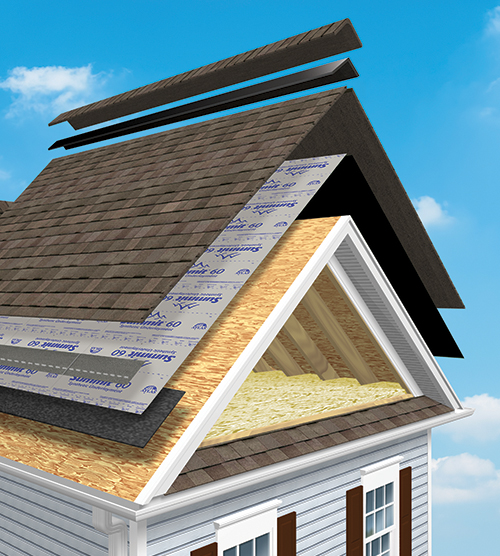How to Avoid Sticker Shock
Understanding the Costs Behind Your New Roof
Carol J. AlexanderWhether you need to replace your roof, want to increase energy efficiency or just aim to spruce things up a bit, a new roof can be an expensive proposition. Before embarking on this large-scale project, start off on the right foot. Proper planning and a little research will help you bring your roofing project in on budget and avoid the hidden costs that can pop up in the process.

Components of the Atlas Signature Select® Roofing System
Typical Expenses for a New Roof
Many homeowners don’t realize that more than just shingles go into a complete roof system. Knowing all the individual components and how they work together will help you understand all of the potential costs involved.
- The roof deck—This is the wooden platform to which your underlayment and shingles are attached. Roof decks are generally made of plywood. An untreated leak could, over time, rot the decking, adding to the cost of the roof.
- Underlayment—Traditionally made of felt paper, the underlayment protects the roof deck from leaks and helps to prolong its life. Now available in synthetic materials, you will replace the underlayment with your roof.
- Starter shingles—Starter shingles run along the edge of the roofline to prevent wind or water penetration. They’re designed to match the main shingles for a consistent appearance.
- Hip and ridge shingles—These shingle accessories are installed where the main shingles meet at the peaks and valleys. The more lines your roof has, the more hip and ridge shingles it will require.
- Main shingles—The shingles cover the main surfaces of your roof.
- Roof vents—Roofs have vents that either lay along the peak of the roof or over an opening cut in the deck, usually on the backside of the roof. These exhaust vents are necessary to work in tandem with soffit vents to keep positive airflow in your attic.
Hidden Costs to Anticipate
In addition to the individual components, your roofing project may incur other costs. Check out this checklist for potential areas to keep in mind such as:
- Prep work expenses—Make sure to count the cost of work that needs to be done in advance of the system replacement. Do you need to hire help to move valuables from your attic, remove artwork or mirrors from your walls, or trim any overhanging tree branches? Will you need to hire childcare or board any pets?
- Damage repair—After removing the old shingles and underlayment, your contractor may find damage from untreated leaks that needs repair. Replacing sections of the roof deck, rafters or fascia will add an additional cost to your job.
- Upgrade options—When choosing shingles for your new roof, you’ll encounter a lot of options. Some upgrades offered by a shingle manufacturer will prolong the life of the shingle, protect its appearance or offer better damage resistance. Other upgrades might include adding roofing ventilation, upgrading your gutter system or choosing a more durable underlayment.
- Tear-off and disposal—When securing a bid for your roof, make sure your contractor includes the cost of tearing off the old material and cleaning up afterward.
How to Plan for The Cost of Your Roof
Now that you have an understanding of the roofing components and their costs and have chosen your upgrades, you have an idea of what a roofing job could cost you. But how are you going to pay for it?
- Insurance—A roof that’s been damaged by a storm may be covered under your homeowner’s insurance. Check with your insurance representative for details.
- Payment plans—Ask your roofing contractor if his or her company offers payment plans for homeowners.
- Personal loan or HELOC—You could finance your roof replacement with a personal loan from your bank or a Home Equity Line of Credit.
- Credit card—Though not the ideal option, if you’re in an emergency situation and none of the other options are available to you, you could pay with a credit card. Yes, the interest rate will be higher than with other options, but in an emergency, delaying the job could increase the cost in the long run.
- Financing—Your contractor may be able to offer financing through one of Atlas Roofing’s partners, which include GreenSky, PowerPay, and Foundation Finance.
To help your budget, plan to have your roof replaced during the off season for your location, if possible. Also, leave 15 to 20 percent wiggle room in the budget for unforeseen expenses and keep the lines of communication open with your contractor.
See the Atlas Difference
Atlas Roofing offers a variety of products with benefits that help to protect your investment and prolong the life of your roof.
For example, Atlas designer shingles featuring Scotchgard™ Protector, such as StormMaster® Shake, are made with copper-containing granules that release copper ions slowly over time, which prevents unsightly black streaks on your roof.
StormMaster® Shake shingles are also manufactured with Core4™ Enhanced Polymer Technology that allows them to resist weather extremes. In fact, StormMaster® Shake shingles can resist winds up to 150 miles per hour and have earned the highest overall rating for hail resistance from the Insurance Institute for Business and Home Safety (IBHS).
If you’re contemplating a new roof, try the Atlas Roof & Home Design Studio to plan your project. Then tell your contractor you want an Atlas roof!
When you choose an Atlas Signature Select® Roofing System, all of the roofing components are designed and backed by the Atlas warranty. For more information about all Atlas products, visit AtlasRoofing.com/roof-shingles.










